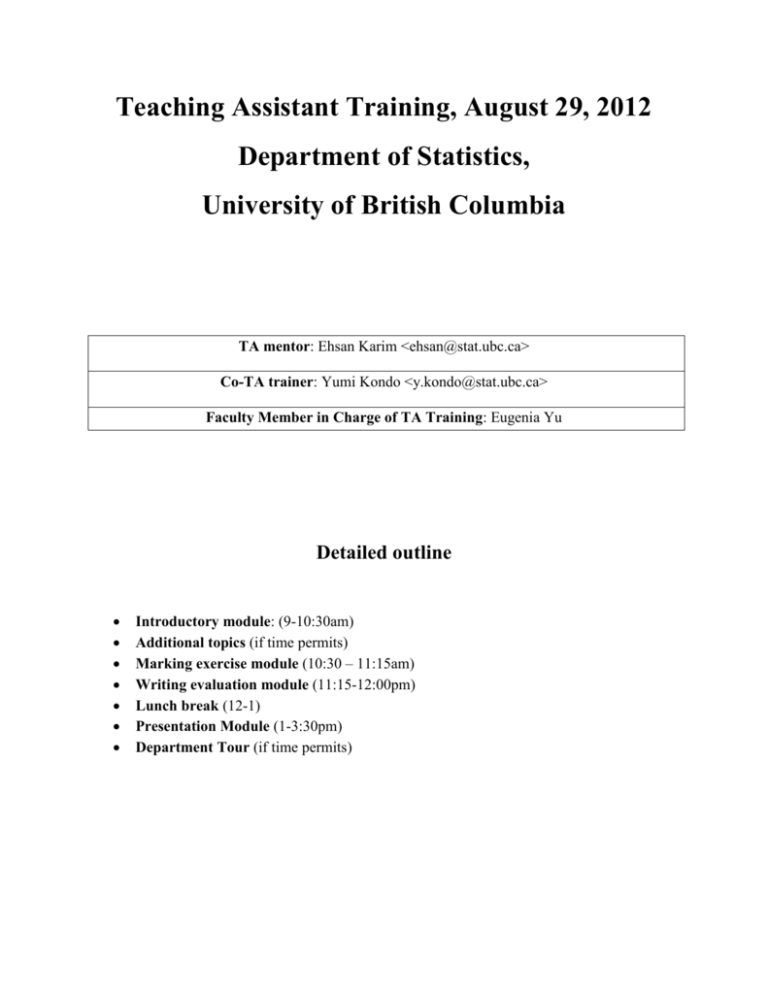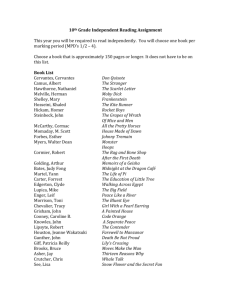Ehsan Karim, Yumi Kondo - UBC Statistics TA Training Home Page
advertisement

Teaching Assistant Training, August 29, 2012 Department of Statistics, University of British Columbia TA mentor: Ehsan Karim <ehsan@stat.ubc.ca> Co-TA trainer: Yumi Kondo <y.kondo@stat.ubc.ca> Faculty Member in Charge of TA Training: Eugenia Yu Detailed outline Introductory module: (9-10:30am) Additional topics (if time permits) Marking exercise module (10:30 – 11:15am) Writing evaluation module (11:15-12:00pm) Lunch break (12-1) Presentation Module (1-3:30pm) Department Tour (if time permits) Introductory module: (9-10:30am) Introduction Mentors Students Purpose of TA training TA duties / TA Job Description Overview of TA job/duties Ice-breaking Bit of practice understanding how things work here learn what is expected of a TA Discussion of issues related to teaching Follow-up later Elements Head TA Limits What we do, how did we get here, etc. Name Home country / university Prior teaching experience and something non-academic Also orientation / grad trip Tutorial / Lab Grading Office hr (regular, special purpose) Website management (Slate/html/connect) Creating assignment questions Creating assignment solutions Preparing lab materials Exam duties Role of head TA - Coordination of TA - Liaison - Solution key - Marking scheme - Distribute/Dividing works among TAs - Upload grades union / Hours / report if overload Good TAing practices What makes you a good TA Good vs bad TA Benefits of being a TA Courses 2xx 3xx 4xx 5xx Respect Responsibility Timeliness Clear Fair Helpful Attentive Attitude Caring Friendly Accessible video Leadership Career Command in basic concepts Time management/organizational skill Influence others as well 200 science 203 arts 241/251 engineering 300 second course in stat 302 probability 305 probability and inference 306 modelling 344 sample survey 404 DOE 450 case study 460/461 inference 560/561 inference 540 high dimensional biology Additional topics (if time permits) Organization Lesson planning Steps Know your responsibilities Allow time to prepare yourself Know materials in advance Know the materials covered in the class Know the approach instructor is following Bridge Objective Pre-assessment Presentation Stress management Presentation skills Use of media Class management Awareness Communication With students, head TA and instructors Share teaching experience With other TAs With head TA/ instructor With mentor Follow-up Participation based Post-assessment Summary Don’t be shy Speak up / loudly Slow down / adjust the pace if stressed Rehearse Encourage participation Stand up straight Make eye contact Face towards the class Repeat the question Make positive remarks Verify if understood Use board often Use visuals Write neatly and big Write down course name and lab # at the beginning Introduce yourself at first lab Make all deadlines and policies clear Don’t apologize for lack of experience/expertise – tell them that you will fix the issue in next lab Handle distraction Balance priorities Don’t give your email address or office address Gender harassment (never date students) Awareness about multi-culture Language in the class decent language Check Emails regularly Seek help if in doubt Help them in the process Report problems early regular informal brown bag lunches in term 1 and 2 Visiting labs Student and instructor evaluation Mentors are available to help Marking Office hours Scheme Verify marking scheme or any changes with head TA/ instructor before marking Course policy Pencil vs pen (see policy of course) Mark homework quickly Keep conversation on track If asked by many, explain in the board, if possible Listen first Don’t give away answers Prepare for next lab if no students come Report cheating, circulate the room and answer students’ questions (no cell phone or other distractions in exam while invigilating) Timeliness Use them effectively Exam invigilation Marking exercise module (10:30 – 11:15am) Marking exercise Mark individually Tips Mark with marking scheme Sample first few Partial credit Penalize once Make comments Consistent / fair grading Plagiarism Cross out blank pages Put check-mark on correct steps Mark what went wrong Write down mark or how much was deducted inside marking scheme more than one possible solution reduce marking time by preparing scheme for all possible solutions Writing evaluation module (11:15-12:00pm) Writing evaluation Writing diagnostic for incoming Statistics graduate students Your answer to each question should be written in a complete paragraph. No pointlike answers will be accepted. The minimum length required is 200 words (for both questions together). Does exercise improve moods for college students? To answer this question, a researcher randomly chooses 50 students who visit the college gym. Among these 50 students, 30 students exercise regularly, and among these 30 students 80% report improvements in their moods after exercise. Answer each of the following questions in a separate paragraph. 1. Can the researcher conclude that exercise leads to improvements in mood? Explain in detail why or why not. 2. Suggest three ways to improve the design of this study to answer the researcher's question. Explain the improvements recommended on the design in detail. Lunch break (12-1) Lunch Location SUB pie-r-square Presentation Module (1-3:30pm) Presentation Department Tour (if time permits) Each student gives a 5-7 minute presentation, followed by critique.






